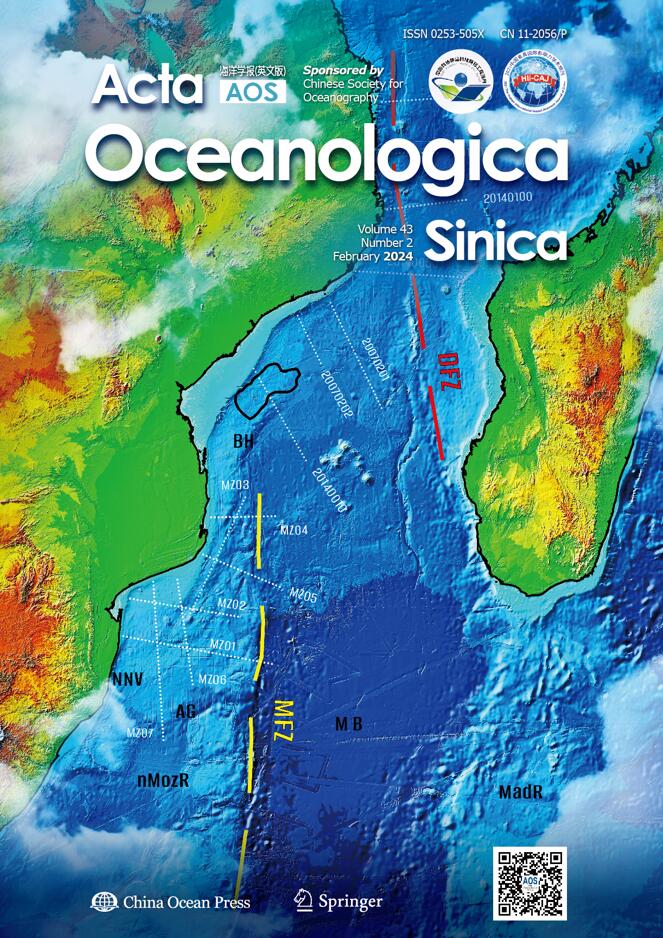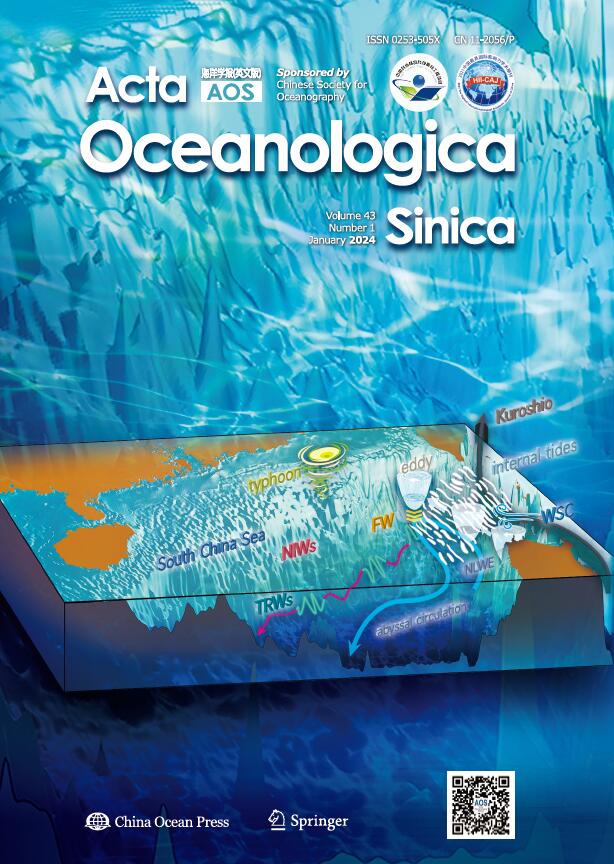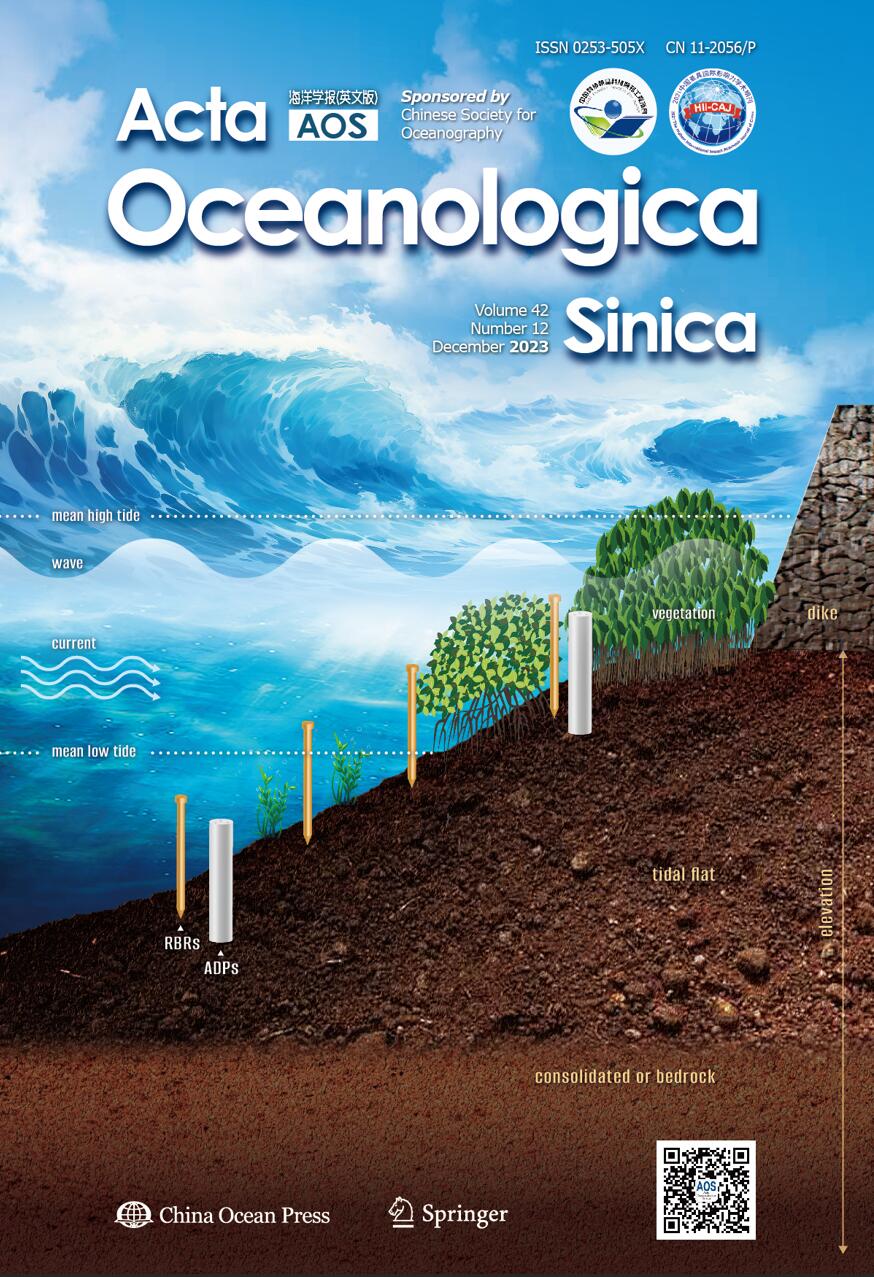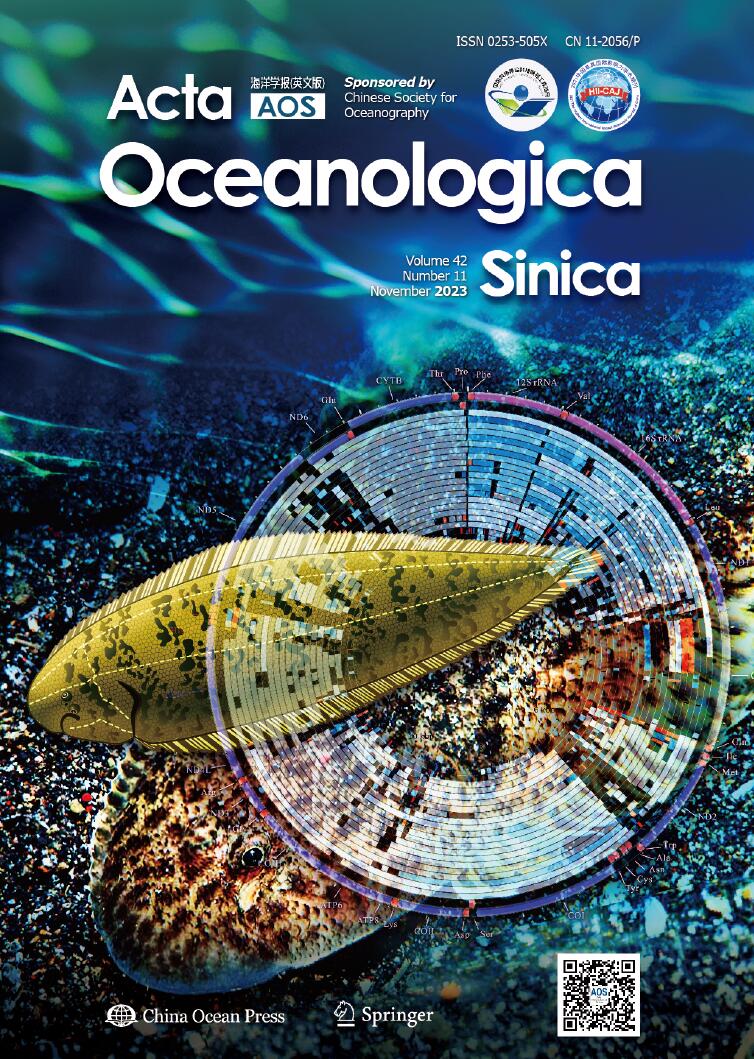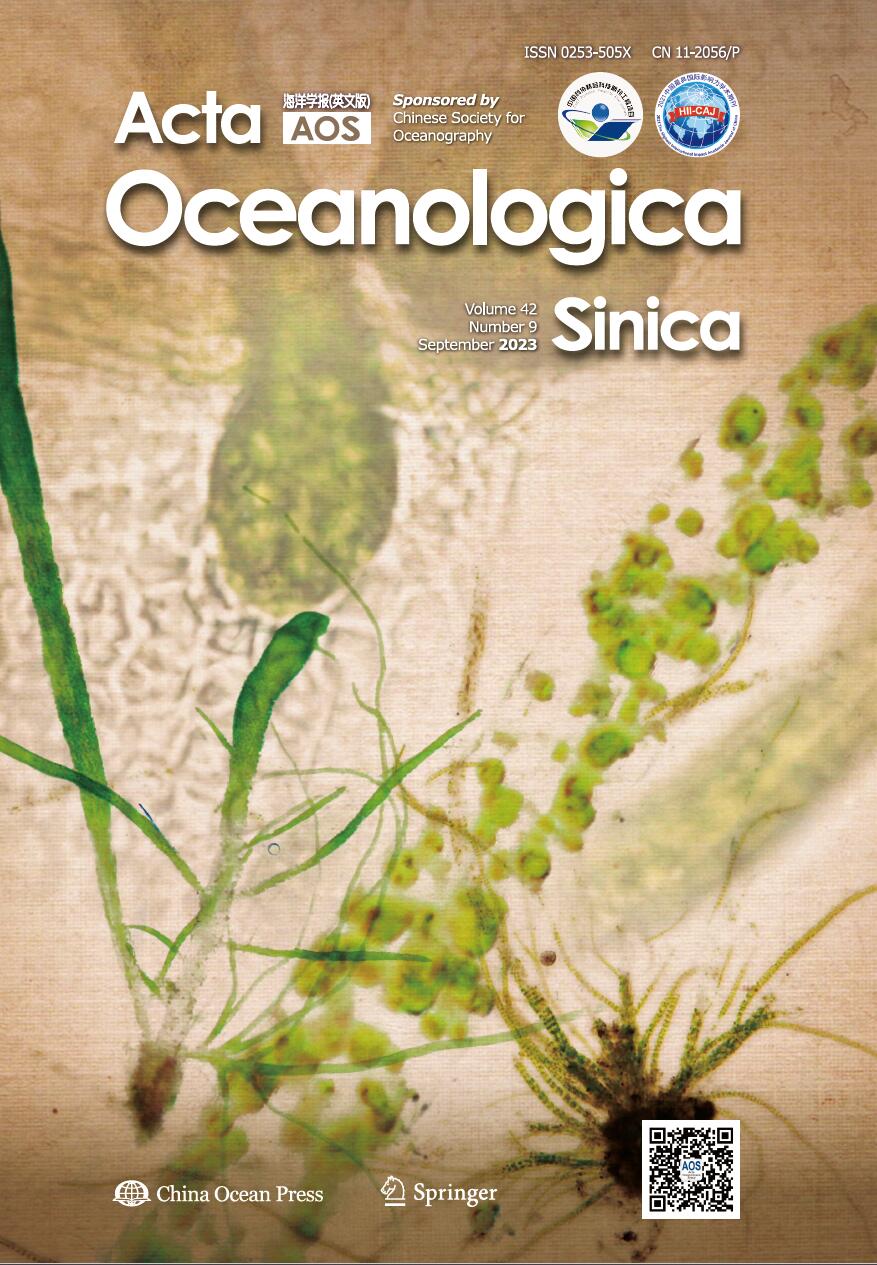2009 Vol. 28, No. 3
column
Display Method:
2009, (3): 1-4.
Abstract:
A class of coupled system of the El Niño/La Niña-Southern Oscillation (ENSO) mechanism is studied. Using the perturbed theory, the asymptotic expansions of the solution for ENSO model are obtained and the asymptotic behavior of solution for corresponding problem is considered.
A class of coupled system of the El Niño/La Niña-Southern Oscillation (ENSO) mechanism is studied. Using the perturbed theory, the asymptotic expansions of the solution for ENSO model are obtained and the asymptotic behavior of solution for corresponding problem is considered.
2009, (3): 5-10.
Abstract:
Mechanical energy input from atmosphere and losses from wave-breaking dissipation of sea surface waves are estimated by a direct scheme. This scheme is based on the integration in the wavenumber space of the wind input and breaking dissipation source functions of the MASNUM wave model. The global amount of wind energy input, averaged in 2005, is about 57 TW, and the wave-breaking dissipation summed in deep-water is about 33 TW, over a half of the wind energy input. The residual may be dissipated by beach processes. Global distributions of the energy input and breaking dissipation concentrate in the westerlies of the Southern Hemisphere.
Mechanical energy input from atmosphere and losses from wave-breaking dissipation of sea surface waves are estimated by a direct scheme. This scheme is based on the integration in the wavenumber space of the wind input and breaking dissipation source functions of the MASNUM wave model. The global amount of wind energy input, averaged in 2005, is about 57 TW, and the wave-breaking dissipation summed in deep-water is about 33 TW, over a half of the wind energy input. The residual may be dissipated by beach processes. Global distributions of the energy input and breaking dissipation concentrate in the westerlies of the Southern Hemisphere.
2009, (3): 11-16.
Abstract:
Observations show that during summer especially in August, the northward expansion of the Changjiang(Yangtze) River diluted water (CRDW) is blocked in the vicinity of the Changjiang Estuary. To explain this phenomenon, Princeton ocean model (POM) is applied to simulate the summertime expansion pattern of CRDW. Numerical experiments show that to the north of the Changjiang Estuary, a tide-induced temperature front of a cold water centered at (34°N,122.5°E) plays the key role in determining the expansion pattern of CRDW. This front splits the CRDW into two parts:the main part expands northeastward, and the other small part expands northwestward off the coast of Jiangsu Province, China.
Observations show that during summer especially in August, the northward expansion of the Changjiang(Yangtze) River diluted water (CRDW) is blocked in the vicinity of the Changjiang Estuary. To explain this phenomenon, Princeton ocean model (POM) is applied to simulate the summertime expansion pattern of CRDW. Numerical experiments show that to the north of the Changjiang Estuary, a tide-induced temperature front of a cold water centered at (34°N,122.5°E) plays the key role in determining the expansion pattern of CRDW. This front splits the CRDW into two parts:the main part expands northeastward, and the other small part expands northwestward off the coast of Jiangsu Province, China.
2009, (3): 17-25.
Abstract:
The characteristics of three-dimensional (3-D) tidal current in the Oujiang Estuary are investigated according to in situ observations. The Oujiang Estuary has features of irregular coastline, complex topography, many islands, moveable boundary, and submerged dyke, therefore, a 3-D numerical model on an unstructured triangular grid has been developed. The σ coordinate transformation, the moveable boundary and submerged dyke treatment techniques were employed in the model so it is suitable for the tidal simulations in the Oujing Estuary with submerged dyke and moveable boundary problems. The model is evaluated with the in situ data, and the results show that the calculated water elevations at 19 stations and currents at 19 profiler stations are in good agreement with measured data both in magnitude and phase. This numerical model is applied to the 3-D tidal circulation simulations of experiments in stopping flow transport through the South Branch of the Oujiang Estuary, and the feasibility to cutoff the flow in the South Branch of the Oujiang Estuary is demonstrated by numerical simulation experiments. The developed numerical model simulated the 3-D tidal current circulations in complicated coastal and estuarine waters very well.
The characteristics of three-dimensional (3-D) tidal current in the Oujiang Estuary are investigated according to in situ observations. The Oujiang Estuary has features of irregular coastline, complex topography, many islands, moveable boundary, and submerged dyke, therefore, a 3-D numerical model on an unstructured triangular grid has been developed. The σ coordinate transformation, the moveable boundary and submerged dyke treatment techniques were employed in the model so it is suitable for the tidal simulations in the Oujing Estuary with submerged dyke and moveable boundary problems. The model is evaluated with the in situ data, and the results show that the calculated water elevations at 19 stations and currents at 19 profiler stations are in good agreement with measured data both in magnitude and phase. This numerical model is applied to the 3-D tidal circulation simulations of experiments in stopping flow transport through the South Branch of the Oujiang Estuary, and the feasibility to cutoff the flow in the South Branch of the Oujiang Estuary is demonstrated by numerical simulation experiments. The developed numerical model simulated the 3-D tidal current circulations in complicated coastal and estuarine waters very well.
2009, (3): 26-39.
Abstract:
Layer-block tectonics (LBT) concept, with the core of pluralistic geodynamic outlook and multilayer-sliding tectonic outlook, is one of new keys to study 3-dimensional solid and its 4-dimensional evolution history of global tectonic system controlled by global geodynamics system. The LBT concept is applied to study the lithospheric tectonics of the southern South China Sea (SCS). Based on the analysis of about 30 000 km of geophysical and geological data, some layer-blocks in the Nansha micro-plate can be divided as Nansha ultra-crustal layer-block, Zengmu crustal layer-block, Nanwei (Rifleman bank)-Andu (Ardasier bank) and Liyue (Reed bank)-North Palawan crustal layer-blocks, Andu-Bisheng and Liyue-Banyue basemental layer-blocks. The basic characteristics of the basemental layer-blocks have been dicussed, and three intra-plate basin groups are identified. The intra-plate basins within Nansha micro-plate can be divided into three basin groups of Nanwei-Andu, Feixin-Nanhua, and Liyue-North Palawan based on the different geodynamics. In the light of pluralistic geodynamic concept, the upheaving force induced by the mid-crust plastic layer is proposed as the main dynamical force which causes the formation of the intra-plate basins within the Nansha micro-plate. Finally, models of a face-to-face dip-slip-detachment of basemental layerblock and a unilateral dip-slip-detachment of basemental layer-block are put forward for the forming mechanisms of the Nanwei-Andu and Liyue-North Palawan intra-plate basin groups, respectively.
Layer-block tectonics (LBT) concept, with the core of pluralistic geodynamic outlook and multilayer-sliding tectonic outlook, is one of new keys to study 3-dimensional solid and its 4-dimensional evolution history of global tectonic system controlled by global geodynamics system. The LBT concept is applied to study the lithospheric tectonics of the southern South China Sea (SCS). Based on the analysis of about 30 000 km of geophysical and geological data, some layer-blocks in the Nansha micro-plate can be divided as Nansha ultra-crustal layer-block, Zengmu crustal layer-block, Nanwei (Rifleman bank)-Andu (Ardasier bank) and Liyue (Reed bank)-North Palawan crustal layer-blocks, Andu-Bisheng and Liyue-Banyue basemental layer-blocks. The basic characteristics of the basemental layer-blocks have been dicussed, and three intra-plate basin groups are identified. The intra-plate basins within Nansha micro-plate can be divided into three basin groups of Nanwei-Andu, Feixin-Nanhua, and Liyue-North Palawan based on the different geodynamics. In the light of pluralistic geodynamic concept, the upheaving force induced by the mid-crust plastic layer is proposed as the main dynamical force which causes the formation of the intra-plate basins within the Nansha micro-plate. Finally, models of a face-to-face dip-slip-detachment of basemental layerblock and a unilateral dip-slip-detachment of basemental layer-block are put forward for the forming mechanisms of the Nanwei-Andu and Liyue-North Palawan intra-plate basin groups, respectively.
2009, (3): 40-49.
Abstract:
The paper focuses on the characteristics of faulting and magmatism of the Okinawa Trough and the relation between them. En-echelon grabens are ranked oblique to the continental shelf edge uplift, and the Longwang uplift, the rifting block ridge in the northern segment and the "Mianhua uplift" in the southern segment have possibly preserved characteristics of volcanism and magmatism occurring with those rifting phases. The clockwise rotation of the southern Ryukyu Islands, driven by collision between Luzon and Taiwan, has played a key role in the crustal oceanization, enhancing the crustal extension of the southern segment and inducing volcanic magmatism in those grabens, among which the Yaeyama graben is a typical example of the presence of oceanic crust. Faulting and magmatism were mainly migrating towards the island arc asymmetrically. The crustal oceanization of the Okinawa Trough is difficultly interpreted by the linear magnetic anomaly model, which is fit for the symmetric spreading of the mid-oceanic ridges.
The paper focuses on the characteristics of faulting and magmatism of the Okinawa Trough and the relation between them. En-echelon grabens are ranked oblique to the continental shelf edge uplift, and the Longwang uplift, the rifting block ridge in the northern segment and the "Mianhua uplift" in the southern segment have possibly preserved characteristics of volcanism and magmatism occurring with those rifting phases. The clockwise rotation of the southern Ryukyu Islands, driven by collision between Luzon and Taiwan, has played a key role in the crustal oceanization, enhancing the crustal extension of the southern segment and inducing volcanic magmatism in those grabens, among which the Yaeyama graben is a typical example of the presence of oceanic crust. Faulting and magmatism were mainly migrating towards the island arc asymmetrically. The crustal oceanization of the Okinawa Trough is difficultly interpreted by the linear magnetic anomaly model, which is fit for the symmetric spreading of the mid-oceanic ridges.
2009, (3): 50-58.
Abstract:
To obtain information on food web structure in salt marshes of the Changjiang (Yangtze) River Estuary, the δ13C and δ15N values of primary producers and consumers were determined. The mean δ13C values of 31 dominant consumers ranged from -23.13‰ to -14.37‰. Except for several species (Eriocheir sinensis, Sinonovacula constricta and Potamocorbula ustulata), consumers had intermediate δ13C values between those of benthic microalgae and Spartina alterniflora. The mean δ15N values of 31 dominant consumers varied between 6.87‰ and 13.33‰, which indicate three trophic levels in salt marshes of the Changjiang River Estuary. A total of 18 macroinvertebrates species and four fish species represented primary consumers with trophic levels ranging from 2.0 to 2.7. Secondary consumers included two macroinvertebrates and seven fishes with trophic levels varying between 3.0 and 3.9. The consumers were divided into three trophic guilds, i.e., detritivorous/algae feeders, omnivores and carnivores. The detrital food chain was the main energy flow pathway in the salt marsh food web of the Changjiang River Estuary, and the marsh vascular plants were at least as equally important as microphytobenthos for secondary production. The important trophic function of the salt marsh habitats in the estuary is revealed.
To obtain information on food web structure in salt marshes of the Changjiang (Yangtze) River Estuary, the δ13C and δ15N values of primary producers and consumers were determined. The mean δ13C values of 31 dominant consumers ranged from -23.13‰ to -14.37‰. Except for several species (Eriocheir sinensis, Sinonovacula constricta and Potamocorbula ustulata), consumers had intermediate δ13C values between those of benthic microalgae and Spartina alterniflora. The mean δ15N values of 31 dominant consumers varied between 6.87‰ and 13.33‰, which indicate three trophic levels in salt marshes of the Changjiang River Estuary. A total of 18 macroinvertebrates species and four fish species represented primary consumers with trophic levels ranging from 2.0 to 2.7. Secondary consumers included two macroinvertebrates and seven fishes with trophic levels varying between 3.0 and 3.9. The consumers were divided into three trophic guilds, i.e., detritivorous/algae feeders, omnivores and carnivores. The detrital food chain was the main energy flow pathway in the salt marsh food web of the Changjiang River Estuary, and the marsh vascular plants were at least as equally important as microphytobenthos for secondary production. The important trophic function of the salt marsh habitats in the estuary is revealed.
2009, (3): 59-64.
Abstract:
Natural assemblages of marine bacteria were chosen in a batch culture experiments. The impact of varying nitrogen substrate concentrations and the substrate C:N ratios (C:NS) on the bacterial C:N ratio (C:NB), the bacterial growth efficiency (BGE) and ammonium regeneration was mainly examined. The C:NS ratios varied from 5:1 (carbon limitation) to 40:1 (nitrogen limitation) with varying combinations of glucose and NO3-. The C:NB ratio had positive relationship with the C:NS ratio (r=0.93, n=8), whose value was 3.77 when the C:NS ratio was 5:1 but increased to 6.47 when the C:NS ratio was 40:1. These results indicate that the C:NB ratio is a potential diagnostic tool for determining the bacterial growth in natural waters controlled by either, carbon or nitrogen. BGE decreased with the declining nitrate concentration and negatively related to C:Ns (r=-0.51, n=8). The average value of BGE was 0.20. This value was a little lower than other reports, which could be induced by the nitrogen source used in our experiments. Finally, regeneration time of ammonium delayed with the increasing C:NS ratio, which indicates that there were different metabolism mechanisms when bacterial growth was limited by carbon source and nitrogen source.
Natural assemblages of marine bacteria were chosen in a batch culture experiments. The impact of varying nitrogen substrate concentrations and the substrate C:N ratios (C:NS) on the bacterial C:N ratio (C:NB), the bacterial growth efficiency (BGE) and ammonium regeneration was mainly examined. The C:NS ratios varied from 5:1 (carbon limitation) to 40:1 (nitrogen limitation) with varying combinations of glucose and NO3-. The C:NB ratio had positive relationship with the C:NS ratio (r=0.93, n=8), whose value was 3.77 when the C:NS ratio was 5:1 but increased to 6.47 when the C:NS ratio was 40:1. These results indicate that the C:NB ratio is a potential diagnostic tool for determining the bacterial growth in natural waters controlled by either, carbon or nitrogen. BGE decreased with the declining nitrate concentration and negatively related to C:Ns (r=-0.51, n=8). The average value of BGE was 0.20. This value was a little lower than other reports, which could be induced by the nitrogen source used in our experiments. Finally, regeneration time of ammonium delayed with the increasing C:NS ratio, which indicates that there were different metabolism mechanisms when bacterial growth was limited by carbon source and nitrogen source.
2009, (3): 65-74.
Abstract:
A three-dimensional suspended sediment model (SED) developed by the present authors is coupled with the combinatorial model of COHERENS (Luyten et al., 1999) (the three-dimensional coupled hydrodynamical-ecological model for Regional and Shelf Seas) and SWAN (Holthuijsen et al., 2004) (the third generation wave model). SWAN is regarded as a subroutine of COHERENS and gets time-and space-varying current velocity and surface elevation from COHERENS. COHERENS gets time-and space-varying wave relevant parameters provided by SWAN. Effects of wave on current are applied in bottom shear stress, wave-induced depth-dependent radiation stress and surface drag coefficient calculation. At the same time, the damping function of suspended sediment on turbulence is introduced into COHERENS. So the sediment model SED has feedback on circulation model COHERENS. The SED obtains current associated parameters from COHERENS. Then a coupled hydrodynamic-sediment model COHERENS-SED being able to account for interaction between wave and current is obtained. COHERENS-SED is adopted to simulate three-dimensional suspended sediment transport in the Huanghe River delta. In terms of simulation results, there is obvious difference between top and bottom layer of wave-induced longshore current. The values of time series of sediment concentration gotten by COHERENS-SED have, generally, an accepted agreement extent with measurement. Significant wave heights and wave periods obtained by COHERENS-SED show that wave simulation case with current's effect can give better agreement extent with measurement than case without current's effect. In the meantime, suspended sediment concentration distributing rule obtained by COHERENS-SED is similar to former researches and measurement.
A three-dimensional suspended sediment model (SED) developed by the present authors is coupled with the combinatorial model of COHERENS (Luyten et al., 1999) (the three-dimensional coupled hydrodynamical-ecological model for Regional and Shelf Seas) and SWAN (Holthuijsen et al., 2004) (the third generation wave model). SWAN is regarded as a subroutine of COHERENS and gets time-and space-varying current velocity and surface elevation from COHERENS. COHERENS gets time-and space-varying wave relevant parameters provided by SWAN. Effects of wave on current are applied in bottom shear stress, wave-induced depth-dependent radiation stress and surface drag coefficient calculation. At the same time, the damping function of suspended sediment on turbulence is introduced into COHERENS. So the sediment model SED has feedback on circulation model COHERENS. The SED obtains current associated parameters from COHERENS. Then a coupled hydrodynamic-sediment model COHERENS-SED being able to account for interaction between wave and current is obtained. COHERENS-SED is adopted to simulate three-dimensional suspended sediment transport in the Huanghe River delta. In terms of simulation results, there is obvious difference between top and bottom layer of wave-induced longshore current. The values of time series of sediment concentration gotten by COHERENS-SED have, generally, an accepted agreement extent with measurement. Significant wave heights and wave periods obtained by COHERENS-SED show that wave simulation case with current's effect can give better agreement extent with measurement than case without current's effect. In the meantime, suspended sediment concentration distributing rule obtained by COHERENS-SED is similar to former researches and measurement.
2009, (3): 75-81.
Abstract:
A fully nonlinear numerical model based on a time-domain higher-order boundary element method (HOBEM) is founded to simulate the kinematics of extreme waves. In the model, the fully nonlinear free surface boundary conditions are satisfied and a semi-mixed Euler-Lagrange method is used to track free surface; a fourth-order Runga-Kutta technique is adopted to refresh the wave elevation and velocity potential on the free surface at each time step; an image Green function is used in the numerical wave tank so that the integrations on the lateral surfaces and bottom are excluded. The extreme waves are generated by the method of wave focusing. The physical experiments are carried out in a wave flume. On the horizontal velocity of the measured point, numerical solutions agree well with experimental results. The characteristics of the nonlinear extreme-wave kinematics and the velocity distribution are studied here.
A fully nonlinear numerical model based on a time-domain higher-order boundary element method (HOBEM) is founded to simulate the kinematics of extreme waves. In the model, the fully nonlinear free surface boundary conditions are satisfied and a semi-mixed Euler-Lagrange method is used to track free surface; a fourth-order Runga-Kutta technique is adopted to refresh the wave elevation and velocity potential on the free surface at each time step; an image Green function is used in the numerical wave tank so that the integrations on the lateral surfaces and bottom are excluded. The extreme waves are generated by the method of wave focusing. The physical experiments are carried out in a wave flume. On the horizontal velocity of the measured point, numerical solutions agree well with experimental results. The characteristics of the nonlinear extreme-wave kinematics and the velocity distribution are studied here.
2009, (3): 82-92.
Abstract:
Wave decomposition phenomenon and spectrum evolution over submerged bars are investigated by a previously developed numerical model. First, the computed free surface displacements of regular waves at various locations are compared with the available experimental data to confirm the validity of the numerical model, and satisfactory agreements are obtained. In addition, variations of decomposition characteristics with incident wave parameters and the change of energy spectrum for regular waves are also studied. Then the spectrum evolution of irregular waves over submerged bars, as well as the influence of incident peak wave period and the steepness of the front slope of the bar on spectrum evolution, is investigated. Wave decomposition and spectral shape are found to be significantly influenced by the incident wave conditions. When the upslope of the bar becomes 1:2, the length of the slope becomes shorter and will not benefit the generation of high frequency energy, so spectrum evolution is not significant.
Wave decomposition phenomenon and spectrum evolution over submerged bars are investigated by a previously developed numerical model. First, the computed free surface displacements of regular waves at various locations are compared with the available experimental data to confirm the validity of the numerical model, and satisfactory agreements are obtained. In addition, variations of decomposition characteristics with incident wave parameters and the change of energy spectrum for regular waves are also studied. Then the spectrum evolution of irregular waves over submerged bars, as well as the influence of incident peak wave period and the steepness of the front slope of the bar on spectrum evolution, is investigated. Wave decomposition and spectral shape are found to be significantly influenced by the incident wave conditions. When the upslope of the bar becomes 1:2, the length of the slope becomes shorter and will not benefit the generation of high frequency energy, so spectrum evolution is not significant.
2009, (3): 93-113.
Abstract:
The feedback between morphological evolution and tidal hydrodynamics in a wave-dominated tidal inlet, Xiaohai, China is investigated through data analysis and numerical model experiments. Historically, Xiaohai Inlet had two openings, located at the north and south of Neizhi Island (a rocky outcrop), respectively. The evolution of Xiaohai Inlet was dominated by the natural process before 1972. In addition to the natural process, human interventions, including the closure of the north opening, 50% of freshwater reduction, and increase of land reclamation, have altered tidal hydrodynamics and morphological evolution since 1972. A series of numerical model simulations were conducted to investigate the influence of morphological changes on the hydrodynamics and the influence of human activities on the inlet evolution. The natural process has caused narrowing and shoaling of the inlet throat, development of the flood-tidal delta, and shoaling of the tidal channel inside the lagoon. Human interventions have accelerated these changes. Consequently, the tidal propagation from the offshore into the lagoon has been impeded and the tidal energy has been dissipated substantially. Tidal current has changed from ebb-dominant to flood-dominant in most parts of the inlet system whereas the inlet throat has remained as ebb-dominant, the tidal prism has decreased consistently, and sediment has continued to deposit inside the inlet. As a result, the changes of morphology, hydrodynamics, and sediment transport show a positive feedback. The human interventions have had both advantageous and adverse influences on the stability of the inlet. The closure of the North Opening has decreased the longshore sediment input to the inlet, and increased the tidal prism, ebb velocity, and sediment transport in the south opening, thus enhancing the inlet's stability. However, reducing the river discharge and landfill of the tidal flats has resulted in a decrease of the tidal prism, the ebb velocity, and the ability to export sediment, thus having the tendency to deteriorate the inlet's stability. A stability analysis based on a closure curve methodology has shown that Xiaohai Inlet is in a state of dynamic equilibrium at present.
The feedback between morphological evolution and tidal hydrodynamics in a wave-dominated tidal inlet, Xiaohai, China is investigated through data analysis and numerical model experiments. Historically, Xiaohai Inlet had two openings, located at the north and south of Neizhi Island (a rocky outcrop), respectively. The evolution of Xiaohai Inlet was dominated by the natural process before 1972. In addition to the natural process, human interventions, including the closure of the north opening, 50% of freshwater reduction, and increase of land reclamation, have altered tidal hydrodynamics and morphological evolution since 1972. A series of numerical model simulations were conducted to investigate the influence of morphological changes on the hydrodynamics and the influence of human activities on the inlet evolution. The natural process has caused narrowing and shoaling of the inlet throat, development of the flood-tidal delta, and shoaling of the tidal channel inside the lagoon. Human interventions have accelerated these changes. Consequently, the tidal propagation from the offshore into the lagoon has been impeded and the tidal energy has been dissipated substantially. Tidal current has changed from ebb-dominant to flood-dominant in most parts of the inlet system whereas the inlet throat has remained as ebb-dominant, the tidal prism has decreased consistently, and sediment has continued to deposit inside the inlet. As a result, the changes of morphology, hydrodynamics, and sediment transport show a positive feedback. The human interventions have had both advantageous and adverse influences on the stability of the inlet. The closure of the North Opening has decreased the longshore sediment input to the inlet, and increased the tidal prism, ebb velocity, and sediment transport in the south opening, thus enhancing the inlet's stability. However, reducing the river discharge and landfill of the tidal flats has resulted in a decrease of the tidal prism, the ebb velocity, and the ability to export sediment, thus having the tendency to deteriorate the inlet's stability. A stability analysis based on a closure curve methodology has shown that Xiaohai Inlet is in a state of dynamic equilibrium at present.
2009, (3): 114-119.
Abstract:
Some problems concerning the ice forces and ice response spectra are studied from both theoretical and practical points of view. On the basis of structural analysis,the analysis method of ice response spectra is proposed, since it plays an important role in the prediction of maximum structural response in cold regions. And it is illustrated that it is easy to study the structural response to ice using the ice response spectra.
Some problems concerning the ice forces and ice response spectra are studied from both theoretical and practical points of view. On the basis of structural analysis,the analysis method of ice response spectra is proposed, since it plays an important role in the prediction of maximum structural response in cold regions. And it is illustrated that it is easy to study the structural response to ice using the ice response spectra.
2009, (3): 120-128.
Abstract:
Seven stations were established in the Quanzhou Bay (24.73°-24.96°N, 118.50°-118.70°E) in China on three cruises to determine the concentrations of polycyclic aromatic hydrocarbons (PAHs) and the numbers of PAH-degrading bacteria in surface sediments. Assessing the biodegradation potential of indigenous microorganisms by measuring the respiratory intensity with the addition of PAHs in sediment samples was also one of the aims of this study. The results show that the total PAH concentrations of the sediments were 99.23-345.53 ng/g dry weight (d.w.), and the PAHs composition pattern in the sediments was dominated by phenanthrene, fluoranthene and pyrene. The numbers of phenanthrene, fluoranthene and pyrene-degrading bacteria during three cruises were 1.42×103-8.93×104 CFU/g d.w., 8.29×103-9.43×104 CFU/g d.w. and 7.05×103-9.43×4 CFU/g d.w., respectively. The addition of three model PAH compounds (phenanthrene, fluoranthene and pyrene) showed a great influence on the increasing of the microbial activity in the sediments. And there was a significant correlation among the change of respiratory activity, PAH concentration and the number of PAH-degrading bacteria. The change in respiratory activity under PAHs selective pressure could, to a certain extent, indicate the potential degradative activity of the PAH-degrading microbial community.
Seven stations were established in the Quanzhou Bay (24.73°-24.96°N, 118.50°-118.70°E) in China on three cruises to determine the concentrations of polycyclic aromatic hydrocarbons (PAHs) and the numbers of PAH-degrading bacteria in surface sediments. Assessing the biodegradation potential of indigenous microorganisms by measuring the respiratory intensity with the addition of PAHs in sediment samples was also one of the aims of this study. The results show that the total PAH concentrations of the sediments were 99.23-345.53 ng/g dry weight (d.w.), and the PAHs composition pattern in the sediments was dominated by phenanthrene, fluoranthene and pyrene. The numbers of phenanthrene, fluoranthene and pyrene-degrading bacteria during three cruises were 1.42×103-8.93×104 CFU/g d.w., 8.29×103-9.43×104 CFU/g d.w. and 7.05×103-9.43×4 CFU/g d.w., respectively. The addition of three model PAH compounds (phenanthrene, fluoranthene and pyrene) showed a great influence on the increasing of the microbial activity in the sediments. And there was a significant correlation among the change of respiratory activity, PAH concentration and the number of PAH-degrading bacteria. The change in respiratory activity under PAHs selective pressure could, to a certain extent, indicate the potential degradative activity of the PAH-degrading microbial community.



